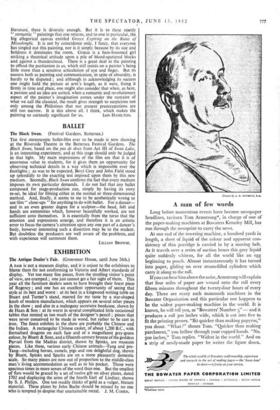ART
WORDS can be confidence-tricksters, and we must walk warily round labels. Delacroix is a " romantic " ; and if me thinks of him relatively, setting him against the neo-classicists and their frigid heirs, or remembering that he visited North Africa, or considering how he admired Byron and saw himself on occasion as Hamlet or Childe Harold, then the word has meaning enough. But it is most inadequate in the face of his painting itself, as one may discover simply at the large exhibition which is being held at Wildenstein's in New Bond Street in aid of the Atelier Delacroix (where the Societe des Amis d 'Eugene Delacroix are creating "a living centre for the study of the life and work of this great master '). It is strange to think that this is the first Delacroix exhibition ever held here ; but then, by a simple irony, his enthusiasm for England has not been answered here by an equal admiration for his paintings.
The first thing that impresses itself is the range and diversity of Delacroix's talent. In the presence of his paintings, where the Venetians and Rubens and Poussin and Constable (and those neo- classicists against whom he reacted with such splendid violence) meet and merge their various influences in Delacroix's own harmonies, making nonsense as often as not of the classical-romantic antithesis, the fog of words is dispersed. There are the studies of animals, at rest or in conflict, symbolical no doubt of the artist's own inward struggles but objective enough in the representation nevertheless. There are the portraits, shrewd in their suggestion of character as well as handsome in pictorial values. Here and there the flower paintings spill their closely observed blossoms into the room. There is a landscape of a cool lyrical purity and strikingly timeless character. Then there are the later decorations in the grand manner, among them [the set of " seasons " which he painted towards the end of his life.
Without considering the works which have as their immediately apparent subject dramatic incidents from history or imaginative literature-, there is diversity enough. But it is to these openly "romantic "paintings that one returns, and to one in particular, the big allegorical canvas entitled Greece Expiring on the Ruins of Missolonghi. It is not by coincidence only, I fancy, that everyone has singled out this painting, nor is it simply because by its size and boldness it dominates the room. Greece is a bare-bosomed girl striking a theatrical attitude upon a pile of blood-spattered blocks and against a thundercloud. There is a great deal in the painting to offend the puritanism in us, which still insists on a painter's being little more than a sensitive articulation of eye and finger. But its success both as painting and communication, in 'spite of absurdity, is hardly to be disputed ; and although in acknowledging its success one might hold the picture at arm's length, as it were, fixing it firmly in time and place, one might also consider that when, as here, a passion and an idea are united, when a romantic and revolutionary aspect of the painter's imagination comes under the restraint of what we call the classical, the result gives strength to suspicions not only among the Philistines that our present preoccupations are still too narrow. It is this above all, I think, which makes the painting so curiously significant for us. IARsi HAMILTON.



































 Previous page
Previous page